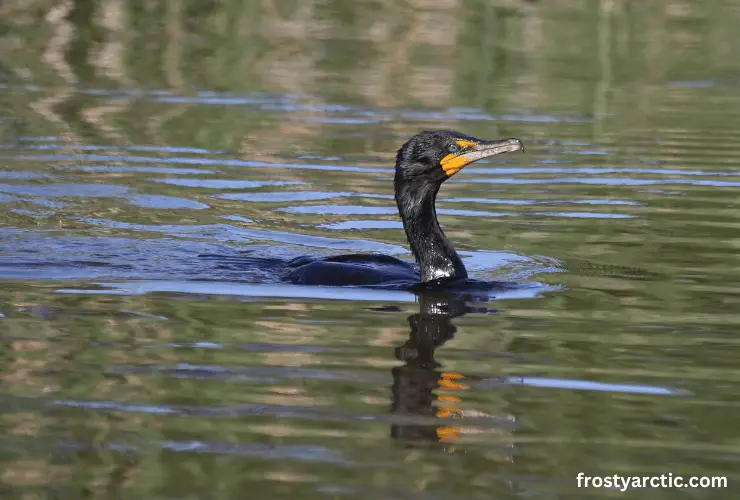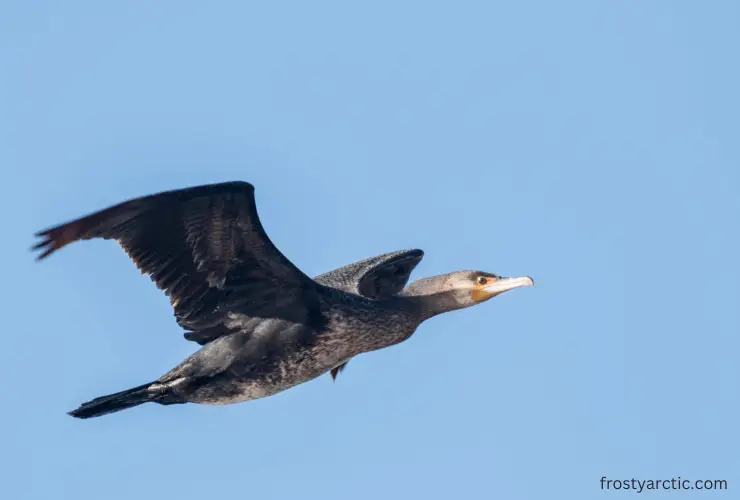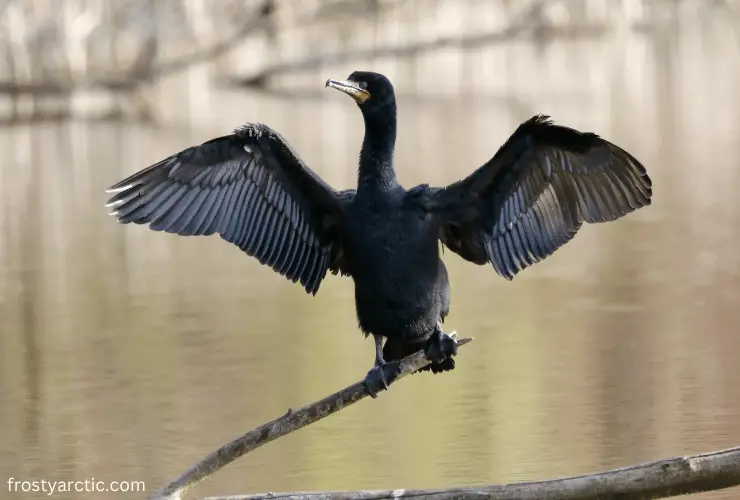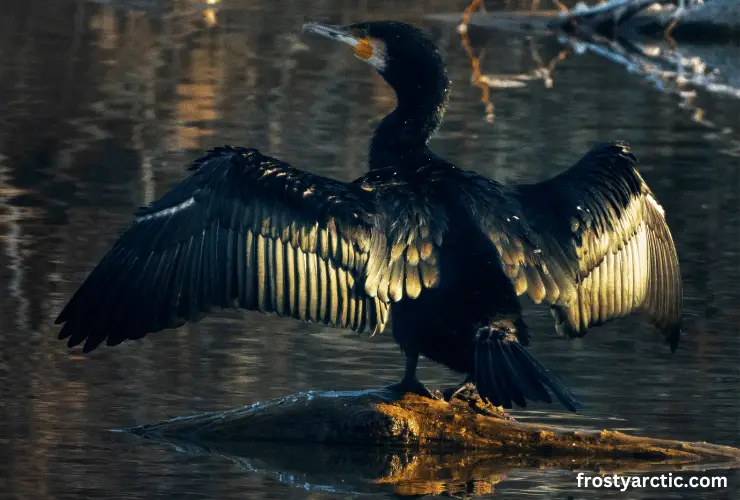No, a cormorant isn’t a duck. The behavior and biological structure of any cormorant specie are way more different than a backyard duck. The cormorant is a great hunter with technical hunting ability underwater. That’s why they have a vast food habit. Whereas ducks are good swimmers with wings helping in swimming rather than flying.
The cormorant (Phalacrocorax carbo) is one of the oldest seabird families and has around 30 species worldwide. You can often see cormorants in a group of hundreds when you reside in North America or UK.
There are a few cormorant species that might look like a duck, or goose when they’re swimming in the water. But in reality, the biological families of ducks and cormorants have a pretty clear and thick lining.
What Type of Bird is a Cormorant? Is it a Duck or a Goose?
In short, a cormorant is a seabird, neither duck nor goose. According to Britannica:
“Though cormorants are traditionally grouped in the order Pelecaniformes, some taxonomists have suggested that on the basis of genetic data, they should be grouped with boobies and gannets (family Sulidae), darters (family Anhingidae), and frigate birds (family Fregatidae) in the order Suliformes.”
So, you can clearly see that even the ancestors of ducks or geese are nowhere related to the Phalacrocoracidae family of seabirds or water birds.

Geese are mainly aquatic birds that can live in any type of water. Whereas the main mating and living areas of cormorants are coastal.
Double-crested cormorants might have a long neck like a swan or goose, but the rest of the physical structure is not the same at all.
What is a Double-Crested Cormorant?
Double-crested cormorants (Nannopterum auritum) are North American water birds that size almost like geese. These variant cormorants also have the basic cormorant instincts and nature.
But because of residing in fresh waters, like their ancestors, people mix double-crested cormorants with geese.
This specie is called double-crested because these cormorants grow large eyebrow-looking feathers over their eyes that have different colors (mostly white) than black or orange.
Double-crested cormorants look like medium-sized ducks when they’re swimming in low water. This type of cormorant has a longer neck with a smaller head.
Most adult double-crests weigh nearly 3 kilograms. They also depend on hunting down small fishes and water snakes with the help of hooked bills.
Ultimately, double-crested cormorants are no different than other Phalacrocoracidae family species.
They just have a larger body structure that is hard to differentiate from the structure of a duck or goose from a distance.
Is a Double-Crested Cormorant a Duck?
Obviously, a double-crested cormorant can never be a duck. This bird species is a far better hunter and aviator than the duck.
If you look closely, Double-rested cormorants look more like long-necked ravens than geese or swans. Like other cormorants, this specie also has the ability to migrate nearby for a better living.

However, the main thing that differentiates double-crested cormorants from ducks is the vegetation preference.
Most sub-families and tribes of ducks live on land grass or water plants. But such type of food is not on the list of cormorants’ food habits.
What is the Difference Between a Cormorant and a Duck?
Now, let’s crack the hard nut. I’m going to show you the key stuff that makes a cormorant and a duck different. Though these two bird types are scientifically proven to be completely different, there are some basic things that even you can understand and separate these two families without being an ornithologist.
Feather
Ducks have waterproof feathers that help them to keep their body dry even if they sink their whole body. But cormorant feathers don’t have any waterproofing coatings. That’s why whenever a cormorant dives or sinks, it needs to dry its body in sunlight after coming near the shore.
Size
Cormorants are larger than ducks. But ducks have larger heads with wider bills generally.
Wings
Ducks have smaller wings than cormorants. Because of this, ducks are unable to fly properly. But other relatives of ducks, geese and swans are expert aviators.
Nesting
Ducks make their nests on the ground. In contrast, cormorants like to nest on artificial ruins, cliffs, trees, etc. You’d rarely see a cormorant nest on the ground.
Food Habit
Ducks live on worms, water plants, small fishes, etc. As ducks aren’t good hunters, they depend on catching small water creatures instead of mid to large fishes.
On the other hand, cormorants have hooked beaks to easily grab fish from underwater and eat them without too much struggle.
Cormorant vs Duck – Comparison Chart
| Cormorant | Duck | |
| Category | Seabird | Aquatic bird |
| Family | Phalacrocoracidae | Anatidae |
| Generally found in | Freshwater, seawater, and inland water | Generally, in inland water and freshwater |
| Population distribution | Coastal regions of North America, UK, Oceania, Coastal Asian regions, etc. | Almost every continent |
| Food habit | Fish, water snakes, and other small beings | Grass, worm, tiny fishes, etc. |
| Nesting Places | Rocky shores, banks, ruins, trees, etc. | Safer grounds |
| Socialization | Always lives with groups | May live with groups |
| Aviation ability | Excellent | Missing |
| Migration | common | Not common |
| Average lifespan | More than 20 years | Less than 10 years |
What is Special about the Cormorant? What Does it Look Like?
It’s pretty rare to see a seabird being a good diver and quality aviator together, and cormorant is the first family that scientists have found to be a part of that rarity.
The term cormorant was constructed from an ancient Latin phrase that meant sea raven.
A cormorant looks like a sea raven because of dark and matte feathers on wings and sounders, eyes like large predator birds, and sharp beaks to strike prey like opportunist hunters.
Although cormorants fly near the grounds and waters, their average speed is somewhere around 40-50 miles/hour.
Along with that, a mature cormorant can dive into 100-foot-deep water in search of prey.
All those specialties are present in the nature of cormorants due to their unique body structure.
The hooked and narrowed bill always plays the main role in grabbing prey firmly. The shape and weight of bones also help them to accelerate in both air and water.

The feathers of cormorants aren’t coated like some other seabird’s feathers. It’s a pretty big reason for them to move flexibly underwater.
But after diving, they require drying the feathers under sunlight on the shores.
Why Do Cormorants Sink?
Cormorant feathers don’t have wax-like coatings to make the body waterproof. Cormorants are among those water birds that don’t have any waterproofing system in their body.
Because of this, they stay on the shores or cliffs after diving, keeping their wings spread to dry up quickly. Otherwise, they’d suffer from cold and die sooner.
The interesting part is the uncoated feathers create the waterlogging mechanism and makes the cormorant body heavier to go into deep water quickly.
How Deep Can a Cormorant Dive?
I’ve already said that cormorants are among those birds that dive better with a decent speed. But they aren’t the deepest divers that dive to thousand-feet deep water.
Normally, an adult or juvenile cormorant with a fully grown body can dive as deep as 100 feet at least. Till now the average deepest dive from cormorants is recorded as 150 feet or so.
FAQ
What are cormorants called in Florida?
People of Florida call every type of cormorant double-crested cormorants because double-crested ones are the most common specie there.
What is cormorant in the Bible?
The word “cormorant” is mentioned a few times in the Bible. At one place, it meant sea swallow in Hebrew. But in other places, it meant Plunging birds and vomiter, most likely.
Is a cormorant a bird of prey?
Yes, a cormorant is a bird of prey. The cormorant family is a predator bird type that consumes fish rather than insects and plants.
What does a double-crested cormorant sound like?
Double-crested cormorants sound like humans snoring and gargling. Some even say that they sound like pigs.
Can you shoot double-crested cormorant?
The US and UK governments have strict laws against harming or hunting cormorants. You can never attempt to cage or hunt a cormorant.
Can you eat double-crested cormorant?
The flesh of predator birds isn’t edible at all. You can eat any cormorant meat. Doing so might push you towards a fatal disease.
Summary
No doubt that cormorants are from a totally different family than ducks. So, asking if cormorant is a duck or not seems pretty odd.
It’s true that they both float on fresh water and don’t have a large body size. But the general habits inherited from their ancestors don’t match at all.
Cormorants are predators with different living mechanisms that let them cooperate and socialize with themselves only for better survival.
On the other hand, you can find ducks depending on vegetation with shorter lifespans. As a result, it’s impossible to find similarities between the duck family and the cormorant family scientifically.



1 thought on “Is a Cormorant a Duck? [Scientific Explanation]”